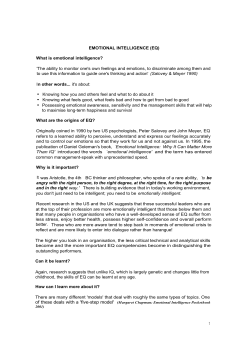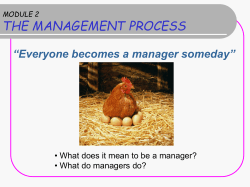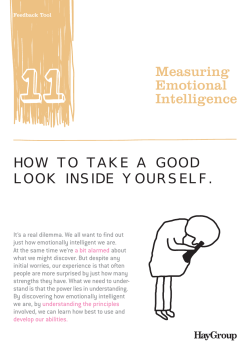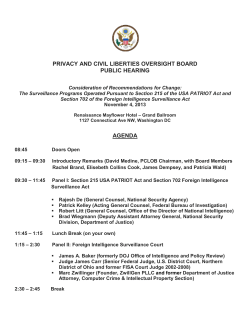
26-Intelligence testing.pptx
Intelligence France 1904 ! The move to universal public education brought many children into the system that were learning poorly. ! Minister of education asked Alfred Binet to devise a means by which children could be identified in their ability to do school work, so that children who needed it could be given a remedial education. First intelligence test introduced in 1906 ! This was to be done in an unbiased manner. – In constructing tests he tried as best he could to use problems that were based on experiences that were equally familiar or strange to all children. – Use of standardized testing. Alfred Binet’s Intelligence test Binet viewed his intelligence test as a way of assessing a child’s ability to perform in school and how this could be used to benefit children in determining where their academic weaknesses were evident so that remedial education could be provided. Unfortunately, his test was used as an argument for not providing further education because many people saw intelligence as innate and unchangeable. Alfred Binet’s Intelligence Test Binet’s assumptions ! School ability could be measured by tests of high-level abilities (problem solving, reasoning), rather than low level abilities (perception, sensory discriminations etc.). ! Since the ability to do well in school increases with age, test items should be used that indicate this changing ability. – Mental Age Items. From fail to pass over short age intervals. – Child who passed items that were solved by an average 8 year old was considered to have a mental age of 8. Lewis M. Terman and the Stanford Binet 1916 L. M. Terman ! Popularized intelligence testing in the United States, started his work on intelligence with his doctoral dissertation, entitled Genius and Stupidity: A Study of the Intellectual Processes of Seven "Bright" and Seven "Stupid" Boys. It involved how to distinguish people of high and low intelligence. ! Terman believed that intelligence was inherited and was the strongest predictor of one's ultimate success in life. He believed the work on intelligence provided powerful scientific evidence to buttress the belief in a fixed intelligence because it is determined by their biological inheritance. He thought that the IQ test could help identify leaders of society through a means that was fair to all. L. M Terman (1877-1956 L. M. Terman Compulsory Sterilization Terman felt strongly that differences in IQ called for action. Terman was also a prominent eugenicist in the first half of the 20th century and a member of the Human Betterment Foundation, founded in 1928, whose members fought for compulsory sterilization laws in California, which eventually sterilized over 20,000 Californians. It is estimated that about 65,000 were sterilized in 33 states that passed laws. One of those 33 states was Minnesota. The US was the first country to undertake such a program aimed principally at the mentally retarded and mentally ill. When the Nazis came to power they looked to the US, especially California, when considering laws for their own country. After WWII compulsory sterilization lost favor in this country because of its association with the genocidal policies of the Nazis. ! “High-grade or border-line deficiency… is very, very common among Spanish-Indian and Mexican families of the Southwest and also among negroes. Their dullness seems to be racial, or at least inherent in the family stocks from which they come… Children of this group should be segregated into separate classes… They cannot master abstractions but they can often be made into efficient workers… from a eugenic point of view they constitute a grave problem because of their unusually prolific breeding” (The Measurement of Intelligence, 1916, p. 91-92). The Stanford Binet Despite the biases and prejudices of Lewis Terman the test he create was remarkably good. ! He followed Binet’s lead by using a standardized testing procedure to guard against testor bias. ! He used representative samples of children to create norms for his test. ! He regularly revised his test to make it better. In contrast to Binet’s reporting of the assessed mental age of a child Terman introduced the IQ (Intelligence Quotient) score: IQ score = MA/CA X 100 – 10/8 X 100 = 125 – 8/8 X 100 = 100 – 6/8 X 100 = 75 Deviation IQ The IQ Score Invention of the IQ score ! The use of an IQ score made it extremely easy to compare individuals’ performance on the test with ease. – An IQ of 100 was average – Greater than 100 was above average – Less than 100 was below average – All modern IQ tests report results in this manner. ! Over time it became obvious that there were problems with the formula: Same IQ at different ages indicated different percentile rankings. The test was revised to report IQ based on Standard Deviations. Types of Intelligence Tests Individual tests ! Administered by individually by a professional examiner. Approximately one to two hours in length. Group tests ! The test of army recruits in WWII led to the development of paper and pencil tests that could be administered to groups. Infant tests (0 to 2 years) ! Bayley Scales of Infant Development, not too predictive of later intelligence. Based on sensorimotor alertness. ! Joseph Fagan’s tests of infant Intelligence, average correlation .45 with childhood intelligence using habituation (McCall). – Visual reaction time, speed of response to visual stimulus – Rate of habituation – Preference for novelty ! Differences in habituation rates are same across racial and ethnic groups. Single or Multiple Score for Intelligence? From the beginning the test was criticized for using a single score to estimate intelligence. How could one score be suitable in representing the variety of cognitive skills evident in intellectual behavior. On the other hand, the items on the test were quite quite varied and it could be argued that the single score was the average of these various intellectual abilities. But even if that is the case why not use a variety of tests that measure each individual intellectual ability. Single or Multi Dimensional Ability? Factor analysis was used to determine if intelligence is a single factor or multiple factors. Charles Spearman -- Single Dimension, “g” factor ! Because children’s scores on various mental tests are moderately correlated, spearman concluded that there must be a general factor “g” or a general ability that is responsible for this. ! He downplayed the differences in specific abilities on individual tests that he labeled “s” for specific factor. Louis Thurstone -- Multiple Dimensions, 7 primary abilities ! Thurstone found in his studies that the “s” factors were quite large, and that intelligence was really composed of seven factors that he labeled Primary Abilities The Structure of Intelligence Structure of Intelligence Is it “g” or “s”? Charles Spearman - All cognitive abilities share an important core factor or "g" for general ability. The report cards of Charles Spearman's children. Tom Dick Mathematics B C English BC+ Chemistry B+ C Sociology B C Classics BCPsychology B C+ Physics B+ C Anthropology B C+ German B+ C L.L. Thurstone -Intelligence is composed of a number of distinct abilities. The report cards of L. L. Thurstone's children. Tom Dick Mathematics B A English AB+ Chemistry B+ A Sociology C C Classics ABPsychology C C+ Physics B+ A Anthropology C C+ German A+ B Harry AA A A+ A+ A A A A Harry CA C A+ A+ A C A A Modern IQ Tests are Multi-factor Tests WAIS Stanford Binet (Most recent version) G score (IQ) ! Crystallized abilities – Verbal reasoning – Quantitative reasoning ! Fluid-analytic abilities – Abstract/visual reasoning ! Short-term memory Provides an overall IQ as well as: Verbal IQ • Information • Comprehension • Arithmetic • Similarities • Digit Span • Vocabulary Performance IQ • Digit Symbol • Picture Completion • Block Design • Picture Arrangement • Object Assembly Three-Stratum Theory of Intelligence By John Carroll Factors in Intelligence Raymond Cattell’s two factor theory: ! Fluid Intelligence – The ability to reason and to solve novel problems with abstract reasoning skills. Declines with age ! Crystallized Intelligence – The ability to solve problems that depend on knowledge acquired as a result of schooling and other life experiences. Increases with age. ! The implications of this is that older and younger individuals demonstrate their intelligence in different ways. Copyright © 2009 Pearson Education, Inc. Publishing as Allyn & Bacon. Characteristics of Good Tests Reliability and Validity Reliability ! Does the test yield similar scores when child retested? ! The IQ test is very well standardized and based on representative norms. It is a well constructed test, and reliabilities in the mid .80s. Validity ! A test has validity to the extent that it measures what it purports to measure? What intelligence tests measure? Lewis Terman and the Study of Genius Terman believed that the IQ score predicted behavior beyond school performance. His strong belief that IQs were largely the result of biological inheritance led him to conclude that IQs would be good predictors of how well one does in society: !O ccupations ! Mental health ! Social ability, etc. ! Original use was to test the ability to perform in school. Correlation about .50-.60 IQ as a Predictor of Scholastic Achievement. – Do better in school – Predicts best at elementary school level, becomes less predictive the more advanced the level of achievement. – Stay in school longer, in sixth grade it correlates .60 with how much education you will attain. Terman’s Study of “Genius” Predicting Life Success. ! Terman studied the top 3% of the population, 130 IQ – 70% graduated from college – 86% have jobs in highest occupational categories – They were happy, healthy, well-adjusted and satisfied with their lives. ! Baller and others studied those with IQs between 60 and 70. – Although they did abysmally in school, had unskilled jobs, lower incomes and less adequate housing, they did relatively well in their jobs and marriages and were largely satisfied. Terman’s Study of Genius Follow-up of Genius Subjects ! As and Bs, differential success but same Level of IQ ! A’s income $24,000, Bs $7,178, national average $5,000 ! As more advantaged, home libraries – Parents stress prudence, forethought, will power, perseverance and desire to excel ! As have less stressful family environments, less divorce ! Terman’s subjects show low artistic creation Revisionist Perspective David McClelland criticism: “...neither professor Terman nor anyone else has yet brought forward conclusive evidence that it is giftedness per se...that is responsible for these happy life outcomes, gifted children were drawn disproportionately from the ranks of the educated, the wealthy, and the powerful. This means that they not only had a better chance to acquire the characteristics measured in the test, but also to be happier (since they had more money), and also to have access to higher occupations and better social standing. IQ and the Gene/Environment Interaction Terman and others has been a simplistic view of the gene/ environment interaction. They assumed that if there is a strong genetic component within groups, the differences between groups would be the result of genes. ! Groups A and B inherit their tallness from their parents. If group A is taller than B, it must be the result of different genes. ! No matter how strong the genetic component within groups the environment still has an effect which could be responsible for the differences between them. Within Variation in IQs A B Between Variation in IQs A C D C D GOOD SOIL B POOR SOIL Cross Fostering Studies Sandra Scarr-Minneapolis study Table 9.6 Ten Environmental Risk Factors Associated with Low IQ and Mean IQs at Age 4 of Children Who Did or Did Not Experience Each Risk Factor. SOURCE: Data and descriptions compiled from Sameroff et al., 1993. Environmental Risks and IQ Are IQ Tests Biased Bias exists if one group has an advantage because of differences that are not related to the ability being tested. Sources of bias ! Unfair test questions? – New York to Paris, bumped in hallway, What is a 747? – “Culture fair” tests continue to show differences ! Testing situations are perceived by minorities as stressful and negatively affect motivation and performance – Does standardized administration of IQ tests make it unfair? ! Edward Zigler found a 7-10 point change if student made more comfortable but….. Lewis Terman and Fixed IQ Terman’s belief in the biological inheritance of IQ also led him to believe in that a person’s IQ was largely fixed and attempts to change it would be ineffective. This was largely accepted by the psychologists of the time. However, later research showed more change than he predicted. Is the IQ Score Fixed Reliability of the IQ test is very good. The scores on the test from one person are very close from one administration to the next over short periods. The question of stability concerns comparisons over longer time periods. Does a person’s IQ score remain constant same with age? Age of child Correlation with IQ at age 18 ! ! ! ! ! 4 6 8 10 12 .42 .61 .70 .76 .76 ! Honzik, Macfarlane and Allen, 1948 Stability of IQ Size of IQ Change from age 6 to age 18 ! ! ! ! ! ! ! Flynn Effect-Stability of IQ Over Generations Flynn effect. From 1918 to 1995, children have increased almost 24 IQ points on Stanford-Binet. 50 or more .5% 30 9% 20 35% 15 58% 10 85% less than 9 15% Honzik, Macfarlane and Allen, 1948 Gainers ! Children from stable, intellectually stimulating homeshad the advantages of home environment which emphasized, supported, and expected achievement in their children. Losers ! Non- supportive, impoverished environments dampen intellectual growth, effects accumulate over time. Culture Fair Tests Changes appear larger on “culture fair” tests (Raven Matrices), which is thought to be a test of fluid abilities, which isn’t supposed to change. Will Remedial Education Work? The hereditarian position was that IQ was fixed because of genetics and could not be changed. ! Negative view of remedial education for children from impoverished environment's because it was a waste of time and money. ! However, when it came to children with high IQs, they reversed themselves arguing that they should be given monetary support to ensure their educational development. Research shows the opposite may be true. Investigators found that heritability differed between the uppermiddle-class and impoverished families ! ! ! ! Upper middle-class, quite high -- .74 Impoverished families, quite low -- .26. (Rowe, Jacobson, & Van den Oord, ’99). This suggests that trying to change IQs in the upper-middle classes families is a\waste of time since they largely dependent on genes, but it would be well worth the money to provide support for the impoverished class since 74% of the variation in IQ is the result of variation in the environment. Remedial Education Research shows the opposite may be true. Investigators found that heritability differed between the uppermiddle-class and impoverished families ! Upper middle-class, quite high -- .74 ! Impoverished families, quite low -- .26. ! (Rowe, Jacobson, & Van den Oord, ’99). Impoverishment Takes Its Toll Affluent children scores in academics about the same regardless of country but those of who are poor do much worse. What does it mean when the curve is steeper in US? This study suggests that trying to change IQs in the upper-middle classes families is a waste of time since they largely dependent on genes, but it would be well worth the money to provide support for the impoverished class since 74% of the variation in IQ is the result of variation in the environment. Compensating for Poor Environments Head Start-Begun in 1965 as part of Great Society programs ! Child given 1 to 2 years preschool experience, nutritional and medical services. ! Parent involvement crucial-serve on councils, planning, working in classroom, receive help on parenting, child development, and help for social, emotional and occupational needs. Studies of high quality university programs found: ! Increase in IQ and achievement in first 2-3 years of elementary school then “washout effect.” ! But, less likely to be in special education, retained in grade, and more likely to graduate. Positive attitudes toward achievement and motivation. Research On Remedial Education HeadStart ! Goal – provide disadvantaged children the educational experiences that middle-class children were receiving (Head Start) ! Long-term follow-ups – – – – – Higher IQs for 2–3 years, then decline, are the right about IQ More likely to meet basic requirements More likely to complete high school More positive attitudes Less likely to be pregnant or delinquent Problem of bias against Head Start: ! Head Start kids come from more impoverished families and attend poorer schools than controls. ! The importance of supporting and benefiting parents. “Two generation” effects. High/Scope Preschool Intervention Procedure: ! 100 children randomly assigned to enrich preschool program or to no treatment group. ! Weekly home visits were used to improve parenting. ! Graph shows follow up at age 27, but most recent followup at 40 shows continued advantages on measure. Remedial Education Why don’t IQs remain high for children who are given remedial education? We know that IQs remain high in impoverished children who are adopted by middle class families. It may be that changes in IQ entails a rather whole scale change in a person’s environment. Cumulative Deficit Hypothesis--Impoverished environments lead to children increasingly falling behind as they grow older.
© Copyright 2025









